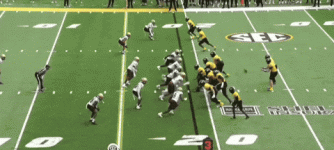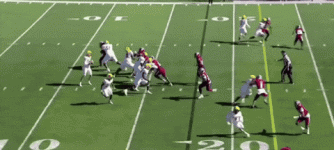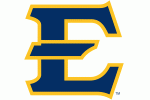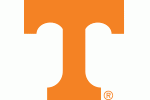- Joined:
- Sep 28, 2014
- Posts:
- 8,639
- Liked Posts:
- 10,177
- Location:
- Chicago, IL
Luther Burden III went through a Rolodex of pro comparisons in my mind while watching his tape from Missouri. There was some Emmanuel Sanders, some Deebo Samuel, some AJ Brown. He has such a wide range of skills that it was hard to pin him down.
But just watching him run, he looks like the wide receiver equivalent to Adrian Peterson.

Obviously that's not the proper player comparison for Burden since he's a wide receiver. But when you watch him run with the ball after the catch, Peterson is who he looks like. He has the same aggressive, violent running style. He makes great use of jump cuts. Defenders melt off of him as he powers his legs through contact. And his vision allows him to always attack the space.
On this first play against Mississippi State, Burden turns sharply on a short curl route so that he settles in the soft spot of the coverage. The defence blitzed from his side. Burden recognized it and cut his route off so he could catch the quick throw.
That initial space is maximized by Burden's short-area acceleration. He goes past the linebacker and has already gained great yardage by this point.
He somehow uses a jump cut to go back across the face of the covering linebacker. He gains a lot of depth, but the quality of the cut allowed him to beat the defender cleanly so he could accelerate again.
The high knees and power into contact allows him to break multiple tackles.
Now, Adrian Peterson made plays like that one against NFL linebackers and defensive backs. Burden is only doing it against college players. Still, there's no reason to think he can't thrive after the catch against NFL defensive backs.
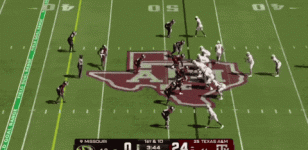
Burden has a relatively large frame for a wide receiver.
He's 6'0" and 206 lbs. The weight he carries doesn't work against him, which means he can make quick, sharp cuts in tight spaces to turn away from defenders.
This out route against Texas A&M should have been stopped short of the first down line. But his ability to stop his momentum in an instant allows him to beat the cornerback.
What's vital here is Burden's technique. He's setting up to turn as he's catching the ball. He catches it with both feet of the ground and sinks his hips into his first step after securing the ball.
By sinking down and shortening his stride, he can push off at an angle infield before making a second cut at the first down line. This is the type of move Michael Crabtree made for Texas Tech over and over again before going onto a very strong career with the San Francisco 49ers.
Crabtree never had high-end NFL speed. Burden might not either. He only ran a 4.4 at the combine. But he plays very fast so that might not be a fair representation of how fast he'll be at the next level.
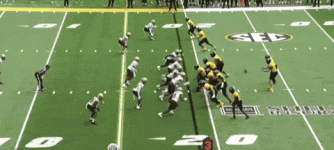
Adding Burden to your offence means giving your quarterback a target who can take short, simple throws and turn them into big gains. Missouri gave him a lot of end-arounds and drew up plays to get the ball in his hands.
He was effective on those play designs but it's not really the best way of incorporating him into an offence. Burden is effective in structured plays with specific blocking around him. But he thrives in broken play after running a route downfield.
This touchdown is the same route as the previous play. The space Burden got after turning around allowed him to set the defence up for a cutback through bodies and into the endzone.

One of the comforting aspects of Burden's play at the college level is how he moved around the offence. He looks like he will be able to play inside or outside at the next level.
This is another quick turnaround over the middle. He shows great awareness to turn away from the arriving safety and then great strength to fight through the defenders for the first down.
We didn't see to many examples of Burden making possession catches running into traffic over the middle of the field. But that looked to be more about the offence and the quarterback than about him.
He relished contact and played strong whenever he needed to.
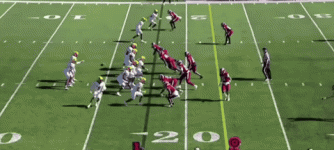
It won't come as a surprise considering the traits that have already been put on show, but Burden is an impressive route runner. He possesses precise feet, quickness, body control and an understanding of space.
This slot route is beautiful. He attacks the outside and wastes no motion in turning back infield. There's a great comfort in how he plants off of either foot and how he repeatedly sinks into his breaks to generate power going back in the opposite direction.
Burden is going to be a nightmare to contain with a two-way go in the NFL. That should set him up to make a lot of important plays on third downs.
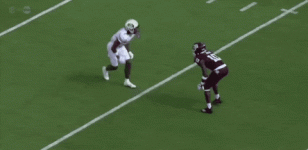
The quick feet and long speed are effective on vertical routes too.
This is a great example of him beating press coverage against Mississippi State. It's one hesitation move and then acceleration into his route. That's exactly what you're looking for from your receiver. Don't waste time. Don't ruin the timing with the quarterback.
It's not flashy, but it's effective and gets the cornerback chasing him early in the route. Burden uses that positioning advantage and then separates at the top of the route with his inside hand.
Subtly pushing off from the defender gives him an uncontested catch. His ball skills here maximize the impact of his larger frame.
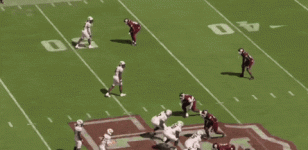
You have a receiver who understands blindpots, leverage and how to drive on cornerbacks to set them up. When you complement those qualities with upper body usage, size, athleticism and good ball skills, you have a receiver who ticks every box.
Burden was worthy of being a top 10 pick in the draft. This is likely why Poles selected him in the 2nd round despite having bigger needs at other positions.
How dominant he can actually be is unclear. He might be lacking the inch or two he'll need to fully dominate NFL defensive backs at the catch point. If we circle back to pro comparisons, Anquan Boldin might be the best in terms of playing style and how rounded he is.
But Boldin was also significantly heavier and slightly taller. Burden might be able to add more size and strength. He’s going to end up a secondary option on a stacked offensive roster. It's not a bad place to be for your long-term career really, it may end up being better for him than going in the top of the draft.
But just watching him run, he looks like the wide receiver equivalent to Adrian Peterson.

Obviously that's not the proper player comparison for Burden since he's a wide receiver. But when you watch him run with the ball after the catch, Peterson is who he looks like. He has the same aggressive, violent running style. He makes great use of jump cuts. Defenders melt off of him as he powers his legs through contact. And his vision allows him to always attack the space.
On this first play against Mississippi State, Burden turns sharply on a short curl route so that he settles in the soft spot of the coverage. The defence blitzed from his side. Burden recognized it and cut his route off so he could catch the quick throw.
That initial space is maximized by Burden's short-area acceleration. He goes past the linebacker and has already gained great yardage by this point.
He somehow uses a jump cut to go back across the face of the covering linebacker. He gains a lot of depth, but the quality of the cut allowed him to beat the defender cleanly so he could accelerate again.
The high knees and power into contact allows him to break multiple tackles.
Now, Adrian Peterson made plays like that one against NFL linebackers and defensive backs. Burden is only doing it against college players. Still, there's no reason to think he can't thrive after the catch against NFL defensive backs.

Burden has a relatively large frame for a wide receiver.
He's 6'0" and 206 lbs. The weight he carries doesn't work against him, which means he can make quick, sharp cuts in tight spaces to turn away from defenders.
This out route against Texas A&M should have been stopped short of the first down line. But his ability to stop his momentum in an instant allows him to beat the cornerback.
What's vital here is Burden's technique. He's setting up to turn as he's catching the ball. He catches it with both feet of the ground and sinks his hips into his first step after securing the ball.
By sinking down and shortening his stride, he can push off at an angle infield before making a second cut at the first down line. This is the type of move Michael Crabtree made for Texas Tech over and over again before going onto a very strong career with the San Francisco 49ers.
Crabtree never had high-end NFL speed. Burden might not either. He only ran a 4.4 at the combine. But he plays very fast so that might not be a fair representation of how fast he'll be at the next level.

Adding Burden to your offence means giving your quarterback a target who can take short, simple throws and turn them into big gains. Missouri gave him a lot of end-arounds and drew up plays to get the ball in his hands.
He was effective on those play designs but it's not really the best way of incorporating him into an offence. Burden is effective in structured plays with specific blocking around him. But he thrives in broken play after running a route downfield.
This touchdown is the same route as the previous play. The space Burden got after turning around allowed him to set the defence up for a cutback through bodies and into the endzone.

One of the comforting aspects of Burden's play at the college level is how he moved around the offence. He looks like he will be able to play inside or outside at the next level.
This is another quick turnaround over the middle. He shows great awareness to turn away from the arriving safety and then great strength to fight through the defenders for the first down.
We didn't see to many examples of Burden making possession catches running into traffic over the middle of the field. But that looked to be more about the offence and the quarterback than about him.
He relished contact and played strong whenever he needed to.

It won't come as a surprise considering the traits that have already been put on show, but Burden is an impressive route runner. He possesses precise feet, quickness, body control and an understanding of space.
This slot route is beautiful. He attacks the outside and wastes no motion in turning back infield. There's a great comfort in how he plants off of either foot and how he repeatedly sinks into his breaks to generate power going back in the opposite direction.
Burden is going to be a nightmare to contain with a two-way go in the NFL. That should set him up to make a lot of important plays on third downs.

The quick feet and long speed are effective on vertical routes too.
This is a great example of him beating press coverage against Mississippi State. It's one hesitation move and then acceleration into his route. That's exactly what you're looking for from your receiver. Don't waste time. Don't ruin the timing with the quarterback.
It's not flashy, but it's effective and gets the cornerback chasing him early in the route. Burden uses that positioning advantage and then separates at the top of the route with his inside hand.
Subtly pushing off from the defender gives him an uncontested catch. His ball skills here maximize the impact of his larger frame.

You have a receiver who understands blindpots, leverage and how to drive on cornerbacks to set them up. When you complement those qualities with upper body usage, size, athleticism and good ball skills, you have a receiver who ticks every box.
Burden was worthy of being a top 10 pick in the draft. This is likely why Poles selected him in the 2nd round despite having bigger needs at other positions.
How dominant he can actually be is unclear. He might be lacking the inch or two he'll need to fully dominate NFL defensive backs at the catch point. If we circle back to pro comparisons, Anquan Boldin might be the best in terms of playing style and how rounded he is.
But Boldin was also significantly heavier and slightly taller. Burden might be able to add more size and strength. He’s going to end up a secondary option on a stacked offensive roster. It's not a bad place to be for your long-term career really, it may end up being better for him than going in the top of the draft.
Attachments
Last edited:






